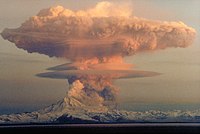
Photo from wikipedia
We read with interest the study by Scheller et al that monitored local field potential (LFP) activity from the globus pallidus (GP) in dystonia patients during a 5 to 7… Click to show full abstract
We read with interest the study by Scheller et al that monitored local field potential (LFP) activity from the globus pallidus (GP) in dystonia patients during a 5 to 7 hour washout following discontinuation of deep brain stimulation (DBS). Even after months of DBS, low-frequency (3 to 12 Hz) oscillations emerged following discontinuation in association with the return of dystonic symptoms. Emergence of lowfrequency oscillations associated with the return of dystonia occurred in the absence of beta (13–30 Hz), suggesting that low-frequency GP oscillations contribute to dystonia and may serve as a biomarker for closed-loop DBS. Similar to dystonia, motor signs in people with Parkinson’s disease (PD) also return gradually following cessation of DBS. Accordingly, the washout dynamics of LFP oscillations should parallel the return of motor signs. Here we report a case study of LFP activity from GP recorded across 6 sessions over 15 months in a 68-year-old man with PD. We examined the washout dynamics of LFPs in alpha (7–13 Hz), low-beta (13–20 Hz), and high-beta (20–30 Hz) frequency bands, the reliability of washout dynamics across sessions and the task dependency (sitting, standing, stepping) of oscillatory activity (see Supplementary Materials for patient characteristics, LFP recording details, and complete results). At each session, DBS was turned off followed immediately by three 30-second trials of sitting, standing, stepping in place, and sitting again (Fig. 1A). The alpha washout dynamics were relatively consistent across 6 replications over 15 months postimplantation with highly reproducible differences in both alpha and beta power between the sitting and standing tasks. A mixed model, with session as random factor was used to examine changes in alpha, low-beta, and highbeta power across time and tasks. The LFP washout dynamics of each session are shown in Figure 1B. When seated, alpha (P = 0.004), but not low-beta (P = 0.77) or high-beta (P = 0.57) power significantly increased over time following discontinuation of DBS. Changes in LFP activity over time were nonsignificant for standing or stepping trials. GP oscillatory activity was also task dependent (Fig. 1C), with power of alpha and low-beta oscillations significantly reduced when standing compared with sitting (alpha, P < 0.001; low-beta, P < 0.001). In contrast, high-beta power (P = 0.007) increased when standing compared with sitting, and low-beta (P = 0.02) and high-beta (P < 0.001) power decreased when stepping compared with standing. The bradykinesia washout period following subthalamic DBS is on the order of 30–50 minutes, but varies across individuals depending on disease duration and stimulation location. Therefore, our 15-minute washout interval probably did not fully capture the LFP washout dynamics. Although our washout period may not have been complete, our observations resemble those of Scheller et al in that we observed a gradual increase in alpha but not beta power following the cessation of GP-DBS. This suggests that pallidal low-frequency oscillations play a role in the expression of symptoms in both PD and primary dystonia. Taken together, these observations further suggest that future closed-loop systems will need to account for multiple-frequency bands as well as their task dependence.
Journal Title: Movement Disorders
Year Published: 2020
Link to full text (if available)
Share on Social Media: Sign Up to like & get
recommendations!